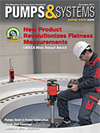Insight and reactions to key industry coverage
"Pumping Prescriptions," December 2011
Click here for full article.
 I enjoyed your recent article, "Shaft Straightening Methods and Procedures." While reading about some of the shaft straightening methods and concerns, images of a blacksmith’s shop came to mind. Part two of your article should also be interesting.
I enjoyed your recent article, "Shaft Straightening Methods and Procedures." While reading about some of the shaft straightening methods and concerns, images of a blacksmith’s shop came to mind. Part two of your article should also be interesting.
In the given bent shaft example, a 90-pound centrifugal force is shown to act on a 72-inch long steel shaft with a 65-pound central load while running in air at 1,800 rpm due to a 0.015-inch eccentric condition. However, it might be interesting to consider that the 90-pounds of centrifugal force might cause the shaft to deflect an additional amount that generates an additional centrifugal force. This increasing deflection and centrifugal force might continue with smaller or larger differences until a stable or destructive equilibrium is reached.
I did not locate any other technical works relating to the dynamic effects of a bent shaft. So, to roughly analyze this process, I used an additional beam equation to determine subsequent shaft deflections from increasing centrifugal forces:
y = F L3 / ( 48 E I )
With a bit of modification to account for the original no-load eccentricity, "e" = y1, the equation, this equation was used:
y = y1 + F L3 / ( 48 E I )
Rearranging to:
F / y = (1 - y1 / y) 48 E I / L3
This was equated to the rearranged centrifugal force equation
F / y = ( W / g ) ( pi N / 30 )2
Where:
y = subsequent shaft deflections
The resulting combined equation was then explicitly solved for the equilibrium maximum deflection, max-y.
max-y ≈ y1 / [ 1 - W ( N / 66.16 )2 L3 / ( E I g ) ]
After a maximum y-value has been calculated from entered data, the equilibrium maximum centrifugal force, max-F, can then be determined by using the max-y value in the centrifugal force equation:
max-F ≈ 0.011 (W / g) ( max-y ) N2
For the published example, assuming that this analysis is remotely applicable and barring any other influences or external restraints, the shaft was predicted per the calculations to catastrophically fail from a process of continuously increasing deflection and centrifugal force increments. If the effective shaft central weight, about 32 pounds, is used instead of the 65-pound load and if the shaft is straightened so that only 0.003-inch of eccentricity/bend remained, a stable equilibrium y-value of about 0.113-inch and approximate corresponding F-value of 332 pounds is calculated. Of course, this was an idealized analysis without any liquid damping, end tensioning, bearing or other effects being considered.
After stable equilibrium values have been determined, the shaft bending stress and natural frequencies might also be checked. Your article statement "centrifugal force can be even greater than the weight of the shaft itself, and therefore, bent shafts are not a good thing" is a very appropriate summation.
Thanks again for your useful and stimulating article.
Lee Ruiz
Oceanside, Calif.
Lev Nelik responds
Lee, thank you for your insightful comments. I am not sure, however, if I totally agree with the additional deflection of the shaft you are suggesting. Note the 0.015-inch deflection stated is what the unbent shaft would have in the middle, if rested horizontally supported at the ends.
You are correct, as stated later in your note, that this static deflection can actually be used to calculate natural frequency of the shaft. In the vertical position, this deflection assumes a perfect shaft is zero. Only if the shaft is indeed bent will the centrifugal force come into play. Also the simplified assumption is, for ballpark reasons, that the bend is in the middle of the shaft, and its weight is also concentrated in the middle. If so, the “blob” of weight sitting at the center will only create centrifugal force if the 0.015-inch deflection became a permanent sag. Otherwise, once the shaft is vertical, there is no deflection.
I, therefore, considered two cases:
- First, the 0.015-inch deflection is only temporarily (briefly rested shaft).
- Second when the shaft has been sitting for a long time, it accumulated these 0.015 inch, and then when it was installed in a vertical pump started to generate centrifugal force due to spin (not due to gravity).
The numbers I calculated are approximate, because in real pumps there are other components that modify this behavior—impellers, bushings, etc. As a result, the combined effect is not exact, but not something that is good for a pump, summarizing the issue in practical terms. I advise practicing maintenance personnel to be careful with long shafts.
The additional notes you shared are also a good thing. Liquid dampening, ends’ buckle, etc.— these all add to the problem. In my younger days at Ingersoll-Rand, we would look at exactly those aspects to make sure the pump design and operation was properly qualified and that any structural or dynamic effects were accounted for and prevented. These days, when the world seems to have moved more toward the pragmatism of “Just tell me what not to do,” beware of a sag is the thing we should try to put out to personnel.
Lee Ruiz responds
Thanks for your reply, Lev. I agree that there should be no centrifugal issue with a vertical pump shaft that is otherwise straight and uniform and only exhibits a 0.015-inch sag when supported horizontally. However, I was basing my response on the paragraph "A permanently bent shaft will . . . centrifugal force will calculate as…” Sparked by your article, the dynamics of an operating bent shaft was interesting to consider.

